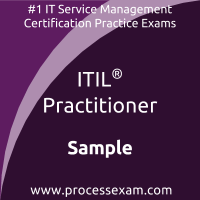The project manager needs to understand how the service desks are working. Which is the BEST action to take first?
a) Visit a representative sample of service desks and their customers; collect the same data from all of them.
b) Speak to all of the service desks and their customers on the telephone; collect the same data from all of them.
c) Send each service desk a questionnaire for staff and customers to complete and return.
d) Visit all service desks; document their current practices and KPIs and talk to their customers.
Which problem has the highest priority, and why?
a) The WiFi connection problem because it will result in significant cost to the university.
b) The keycard management problem because it will result in significant risk to the university.
c) The WiFi connection problem because it will result in significant risk to the university.
d) The keycard management problem because it will result in significant cost to the university.
In the first set of improvements, which elements of the cloud services at GCITS are the MOST important to focus on?
a) Value and outcome.
b) Cost and outcome.
c) Value and risk.
d) Cost and risk.
Which statement BEST describes the purpose of sponsorship within an improvement initiative?
a) To organize and coordinate people's efforts and the allocation of resources to maximize efficiency in achieving identified goals.
b) To ensure support from managers or business leaders to promote the initiative and authorize the change.
c) To analyze key stakeholders in order to assess their power, influence and interest in the improvement initiative.
d) To clarify the role played by managers or business leaders in prioritizing changes during the lifecycle of the initiative.
What is the MOST important reason for using a workshop and meeting action plan?
a) To make sure the equipment needed is available and working.
b) To ensure the workshop covers its objectives.
c) To demonstrate professionalism when planning the workshop.
d) To provide the exact agenda to the workshop delegates in advance.
The local manager in KL knows that the service desk analysts are very likely to resist the change. What is the BEST tactic to overcome this resistance?
a) Work with the internal communications department to publish FAQs on the company intranet.
b) Email the service desk analysts explaining the importance of the improvement to the company.
c) Meet with the service desk analysts and explain how they will benefit from the improvement.
d) Monitor the situation and review in a months’ time to determine if it is still an issue for concern.
Which is the BEST example of using the ITIL concept ‘adopt and adapt’ when delivering improvements?
a) Use the organization’s ITIL compliant toolset to enhance GCITS processes based on improvement priorities.
b) Combine both GCITS and DriveYou.com service management processes to produce a best practice solution that reduces the cost of support.
c) Modify GCITS cloud services to align with ITIL guidance and other best practice frameworks.
d) Enhance GCITS processes based on a gap analysis between current delivery and required benefits, taking ideas from best practices.
An ongoing communications plan includes emails, telephone calls, face-to-face meetings and briefings with various different stakeholders. Which communication principle does this BEST demonstrate?
a) ‘Communication is a two-way process’.
b) ‘We’re all communicating, all of the time’.
c) ‘There is no single method of communication’.
d) ‘Timing and frequency matter’.
Which activity is used to identify areas of weakness for the KL service desk analysts?
a) Managing stakeholders.
b) Analyzing training needs.
c) Managing sponsors.
d) Creating a sense of urgency.
What are the BEST steps to start working on problem management?
a) Implement ITIL problem management, document responsibilities, and create a RACI model authority matrix.
b) Develop process documentation, train service desk, and implement a knowledge base.
c) Hire a problem manager, create a problem management team, and agree targets.
d) Identify commonly recurring incidents, develop work-arounds, and investigate root causes.
 You have to pass the ITIL Practitioner exam to receive the certification credential. To increase the effectiveness of your study and make you familiar with the actual exam pattern, we provide the following sample questions. Our Sample ITIL Practitioner Practice Exam will give you more insight about both the type and the difficulty level of the questions on the ITIL Practitioner exam.
You have to pass the ITIL Practitioner exam to receive the certification credential. To increase the effectiveness of your study and make you familiar with the actual exam pattern, we provide the following sample questions. Our Sample ITIL Practitioner Practice Exam will give you more insight about both the type and the difficulty level of the questions on the ITIL Practitioner exam.